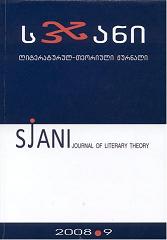სულისა და ხორცის დიქოტომია: ტომას ელიოტის „ჰიპოპოტამი“ და „უკვდავების ჩურჩული“
Dichotomy of Body and Soul: T.S.Eliot's "The Hippopotamus" and "Whispers of Immortality"
Author(s): Temur KobakhidzeSubject(s): Literary Texts
Published by: ლიტერატურის ინსტიტუტის გამომცემლობა
Keywords: allusiveness; parody analogy; skepticism.
Summary/Abstract: ‘Whispers of Immortality’ and ‘The Hippopotamus’ were composed in the middle of the World War 2, while Eliot stayed in London. Sharp ironical, grotesque imagery and even caricature are characteristic of both poems as is their rich allusiveness. They share much of their subject-matter and the theme, although that is hardly recognizable on the surface. Each in its own way, they both deal with the dichotomy of body and soul, the subject that would have been obviously religious had not Eliot regarded it with a great deal of ironic distance and skepticism of an erudite poet-analyst, and by no means with reverence of a devotional poet. Within the basic antithesis of “The Hippopotamus”, that of the hippopotamus and the True Church, smaller antitheses are developed by the major opposites. For example, the hippopotamus seems firm but is frail, while the True Church presents no such opposition; yet this antithesis proves to be truer of the church. The “mysterious way” in whic “God works”, gives us not only the satiric wonder of the sleeping church but also the sympathetic wonder of the limited hippopotamus taking wing and ascending to heaven. Striking similarities between the poem and Jan van Eyck’s Ghent Altarpiece (Adoration of the Mystic Lamb) prove that part of Eliot’s design was to draw a parody analogy with this world famous piece of painting by borrowing from it some of the crucial imagery for his poem. All those quiring angels and ‘martyr’d virgins’, by whom the hippopotamus ‘shall be kist’, ‘the harp of gold’, on which the hippopotamus ‘performs’, ‘blood of the Lamb’, by which he will be cleaned, and ‘the True Church’ itself, personified by a group of high ranked clerics in papal tiaras, etc. are depicted in van Eyck’ altarpiece, which is commonly considered to be one of the most important masterpieces of the 16th century Northern Renaissance painting. Behind all the external irony and grotesque, Eliot’s poem can doubtlessly be perceived as an inter textual context, where by means of a parallel extra textual associations, the motif of the Ghent Altarpiece is explicitly recognized. Parody of the Ghent Altarpiece in “The Hippopotamus” can be identified as part of the main current in Modernist aesthetics and its ideology, which repudiated root and branch the Renaissance values together with what was called ‘humanitarianism’ in T.S.Eliot’s time. The attention, however, is drawn to what we now call the period of relative decline of the High Renaissance values, and the introduction of Mannerism and Baroque, strongly exemplified by the 17th century ‘metaphysical’ poetry and the Jacobean drama. “Whispers of Immortality” makes the use of both bodily lust and spiritual aspirations just like “The Hippopotamus” refers to The Adoration of the Mystic Lamb in its imagery. Eliot's early poetry reflects general skepticism.
Journal: სჯანი
- Issue Year: 2008
- Issue No: 09
- Page Range: 69-84
- Page Count: 16
- Language: Georgian

